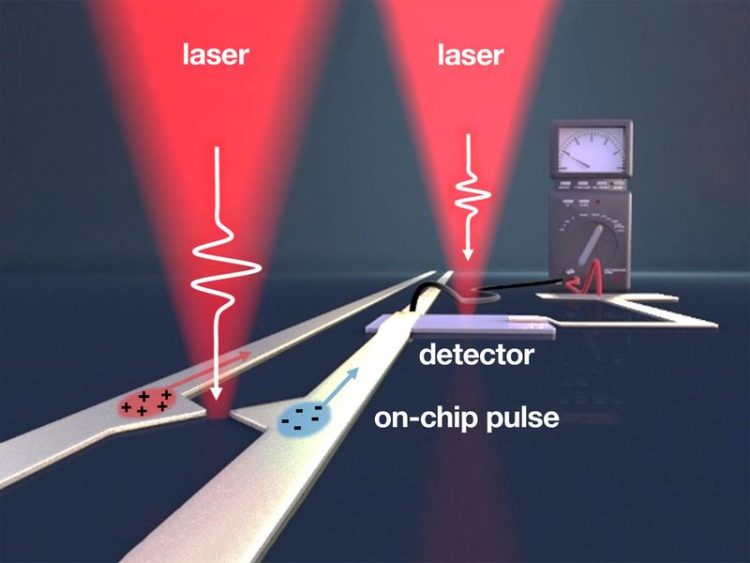Asymmetric plasmonic antennas deliver femtosecond pulses for fast optoelectronics

Pulses of femtosecond length from the pump laser (left) generate on-chip electric pulses in the terahertz frequency range. With the right laser, the information is read out again. Image: Christoph Hohmann / NIM, Alexander Holleitner / TUM
Classical electronics allows frequencies up to around 100 gigahertz. Optoelectronics uses electromagnetic phenomena starting at 10 terahertz. This range in between is referred to as the terahertz gap, since components for signal generation, conversion and detection have been extremely difficult to implement.
The TUM physicists Alexander Holleitner and Reinhard Kienberger succeeded in generating electric pulses in the frequency range up to 10 terahertz using tiny, so-called plasmonic antennas and run them over a chip. Researchers call antennas plasmonic if, because of their shape, they amplify the light intensity at the metal surfaces.
Asymmetric antennas
The shape of the antennas is important. They are asymmetrical: One side of the nanometer-sized metal structures is more pointed than the other. When a lens-focused laser pulse excites the antennas, they emit more electrons on their pointed side than on the opposite flat ones. An electric current flows between the contacts – but only as long as the antennas are excited with the laser light.
“In photoemission, the light pulse causes electrons to be emitted from the metal into the vacuum,” explains Christoph Karnetzky, lead author of the Nature work. “All the lighting effects are stronger on the sharp side, including the photoemission that we use to generate a small amount of current.”
Ultrashort terahertz signals
The light pulses lasted only a few femtoseconds. Correspondingly short were the electrical pulses in the antennas. Technically, the structure is particularly interesting because the nano-antennas can be integrated into terahertz circuits a mere several millimeters across.
In this way, a femtosecond laser pulse with a frequency of 200 terahertz could generate an ultra-short terahertz signal with a frequency of up to 10 terahertz in the circuits on the chip, according to Karnetzky.
The researchers used sapphire as the chip material because it cannot be stimulated optically and, thus, causes no interference. With an eye on future applications, they used 1.5-micron wavelength lasers deployed in traditional internet fiber-optic cables.
An amazing discovery
Holleitner and his colleagues made yet another amazing discovery: Both the electrical and the terahertz pulses were non-linearly dependent on the excitation power of the laser used. This indicates that the photoemission in the antennas is triggered by the absorption of multiple photons per light pulse.
“Such fast, nonlinear on-chip pulses did not exist hitherto,” says Alexander Holleitner. Utilizing this effect he hopes to discover even faster tunnel emission effects in the antennas and to use them for chip applications.
Publication:
Towards femtosecond on-chip electronics based on plasmonic hot electron nano-emitters.
C. Karnetzky, P. Zimmermann, C. Trummer, C. Duque-Sierra, M. Wörle, R. Kienberger, A. Holleitner; Nature Communications June 25, 2018 – DOI: 10.1038/s41467-018-04666-y
https://www.nature.com/articles/s41467-018-04666-y
More information:
The experiments were funded by the European Research Council (ERC) as part of the “NanoREAL” project and the DFG Cluster of Excellence “Nanosystems Initiative Munich” (NIM).
Contact:
Prof. Dr. Alexander Holleitner
Walter Schottky Institute / Department of Physics
Center for Nanotechnology and Nanomaterials
Technical University of Munich
Am Coulombwall 4a, 85748 Garching, Germany
Tel: +49 89 289 11575
E-Mail: holleitner@wsi.tum.de
Web: https://www.wsi.tum.de/groups.php?group=holleitner
Prof. Dr. Reinhard Kienberger
Physik-Department E11
Technical University of Munich
James-Franck-Str. 1, 85748 Garching, Germany
Tel: +49 89 289 12840
E-Mail: reinhard.kienberger@tum.de
Web: http://www.groups.ph.tum.de/e11
https://www.tum.de/nc/en/about-tum/news/press-releases/detail/article/34767/ Link to the press release
Media Contact
All latest news from the category: Power and Electrical Engineering
This topic covers issues related to energy generation, conversion, transportation and consumption and how the industry is addressing the challenge of energy efficiency in general.
innovations-report provides in-depth and informative reports and articles on subjects ranging from wind energy, fuel cell technology, solar energy, geothermal energy, petroleum, gas, nuclear engineering, alternative energy and energy efficiency to fusion, hydrogen and superconductor technologies.
Newest articles

Recovering phosphorus from sewage sludge ash
Chemical and heat treatment of sewage sludge can recover phosphorus in a process that could help address the problem of diminishing supplies of phosphorus ores. Valuable supplies of phosphorus could…

Efficient, sustainable and cost-effective hybrid energy storage system for modern power grids
EU project HyFlow: Over three years of research, the consortium of the EU project HyFlow has successfully developed a highly efficient, sustainable, and cost-effective hybrid energy storage system (HESS) that…

After 25 years, researchers uncover genetic cause of rare neurological disease
Some families call it a trial of faith. Others just call it a curse. The progressive neurological disease known as spinocerebellar ataxia 4 (SCA4) is a rare condition, but its…





















